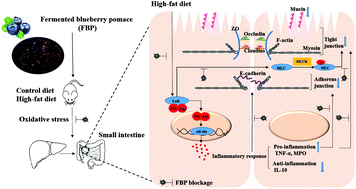Fermented blueberry pomace ameliorates intestinal barrier function through the NF-κB-MLCK signaling pathway in high-fat diet mice†
Abstract
The barrier-improving functions of fermented blueberry pomace (FBP) and its potential mechanism were investigated in this study. Polyphenols and the approximate composition of FBP were evaluated according to the National Standard of the People's Republic of China and the UPLC-MS system. Male C57BL/6 mice were fed a control diet (CD) or a high-fat diet (HFD) with or without FBP supplementation. Oxidative stress, inflammation, histological morphology and the expression of functional proteins in the small intestine of mice were evaluated using the enzyme linked immunosorbent assay (ELISA), quantitative polymerase chain reaction (qPCR) and western blotting. The content of protein, fat, soluble dietary fiber, insoluble dietary fiber and carbohydrates (non-dietary fiber) was 114.5 ± 1.5 g kg−1, 5.0 ± 0.2 g kg−1, 48.0 ± 0.1 g kg−1, 360.3 ± 2.2 g kg−1 and 423 g kg−1 (by difference), respectively. Thirty-six polyphenols were identified in FBP. FBP improved the growth of mice and attenuated hepatic and intestinal oxidative stress. Intestinal inflammation was significantly reduced through the decrease of tumor necrosis factor-alpha (TNF-α) and myeloperoxidase (MPO) as well as an increase of interleukin-10 (IL-10). FBP supplementation significantly improved the intestinal morphology and barrier function, potentially by mediating the NF-κB-MLCK signaling pathway. The supplementation of FBP in HFD mice enhanced the intestinal barrier function. This suggested that polyphenol-rich by-products might provide a similar health effect in HFD individuals.



 Please wait while we load your content...
Please wait while we load your content...